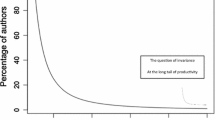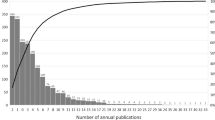Abstract
In three biomedical research institutions, there is no indication of a single laboratory size at which the number of publications per scientist is maximal or minimal. In a scattergram of the number of publications of a laboratory against laboratory size, the horizontal coordinate measures the number of scientists in a laboratory, the vertical axis measures the number of publications from the laboratory (counting each publication once regardless of the number of authors), and each laboratory is represented by one point. Scattergrams for the Rockefeller University (RU), New York, the National Institute for Medical Research (NIMR), London, and the National Cancer Institute (NCI), Bethesda, are each described well by a straight line through the origin. The slopes of the lines for the three institutions are not significantly different. In these laboratories, ranging in size from 1 to 46 scientists, one additional scientist increases the expected annual number of publications of a laboratory by approximately 1.1, regardless of the size of the laboratory. Although the three institutions have significantly different mean laboratory sizes, the frequency distribution of laboratory size in each institution is described well by a 0-truncated negative binomial distribution, as predicted by a simple model of laboratory population dynamics.
Similar content being viewed by others
Notes and References
J. E. COHEN, Publication rate as a function of laboratory size in a biomedical research institution,Scientometrics 2 (1980) 35–52.
National Institute for Medical ResearchReport for 1976–77. Medical Research Council. London 1977.
National Institutes of Health,Scientific Directory 1978; Annual Bibliography 1977. DHEW Publication (NIH) 78-4. Bethesda, MD: National Institutes of Health, Division of Scientic Reports, 1978.
G. W. SNEDECOR, W. G. COCHRAN,Statistical Methods 6th ed. Iowa State University Press, Ames 1967, p. 168–170.
Ibid.—, p. 53.
Ibid.—, p. 167.
P. ARMITAGE,Statistical Methods in Medical Research. Blackwell Scientific, Oxford 1971.
D. de SOLLA PRICE, D. deB. BEAVER, Collaboration in an invisible college,American Psychologist 21 (1966) 1011–1018.
R. A. FISHER,Statistical Methods for Research Workers 14th ed. Oliver and Boyd Edinburgh 1970, p. 58.
C. R. RAO, I. M. CHAKRAVARTI, Some small sample tests of significance for a Poisson distribution,Biometrics 12 (1956) 264–282.
W. BRASS, Simplified methods of fitting the truncated negative binomial distribution,Biometrika 45 (1958) 59–68.
SNEDECOR, COCHRAN, op. cit., p. 403.
R. STANKIEWICZ, The size and age of Swedish academic research groups and their scientific performance, Chapter 8, 1979, pp. 191–222, in ANDREWS24 see p. 203.
J. T. WALLMARK, S. ECKERSTEIN, B. LANGERED, H. E. S. HOLMQVIST, The increase in efficiency with size of research teams,IEEE Transactions on Engineering Management EM-20 (3) (1973) 80–86.
R. C. DAILEY, The role of team and task characteristics in R & D team collaborative problem solving and productivity,Management Science 24(15) (1978) 1579–1588.
R. H. ORR, G. ABDIAN, A. A. LEEDS, Generation of information: published output of U. S. Biomedical research,Federation Proceedings 23 (1964) 1297–1309, see p. 1303.
D. de SOLLA PRICE,Little Science, Big Science. Columbia University Press, New York 1963, see pp. 40–50.
J. E. COHEN, Markov population processes as models of primate social and population dynamics,Theoretical Population Biology 3 (1972) 119–134.
Price, Beaver, op. cit., p. 1016, Table 2, column headed “G”.
Ibid., p. 1016, Table 2, column headed “G”.
ORR et al., p. 1305.
Survey of Current Business U. S. Department of Commerce, Bureau of Economic Analysis, Washington, D. C. 60(1) (1980) 40.
K. SUBRAHMANIAM, K. SUBRAHMANIAM, On the estimation of the parameters in the bivariate negative binomial distribution,Journal of the Royal Statistical Society B 35 (1973) 131–146.
F. M. ANDREWS, (Ed.)Scientific Productivity: The Effectiveness of Research Groups in Six Countries. Cambridge University Press; 1979 Paris Unesco, 1979
Author information
Authors and Affiliations
Rights and permissions
About this article
Cite this article
Cohen, J.E. Publication rate as a function of laboratory size in three biomedical research institutions. Scientometrics 3, 467–487 (1981). https://doi.org/10.1007/BF02017438
Received:
Revised:
Issue Date:
DOI: https://doi.org/10.1007/BF02017438




